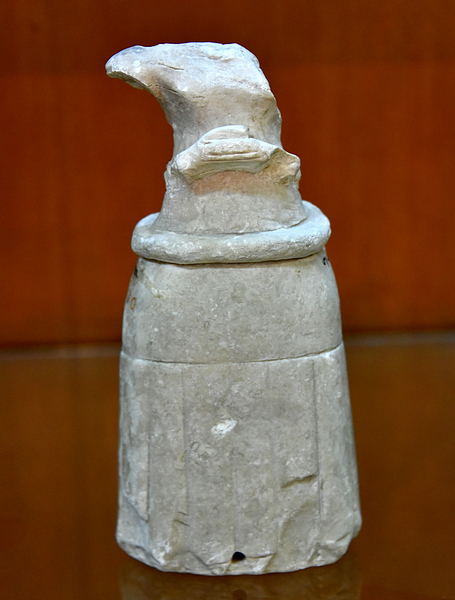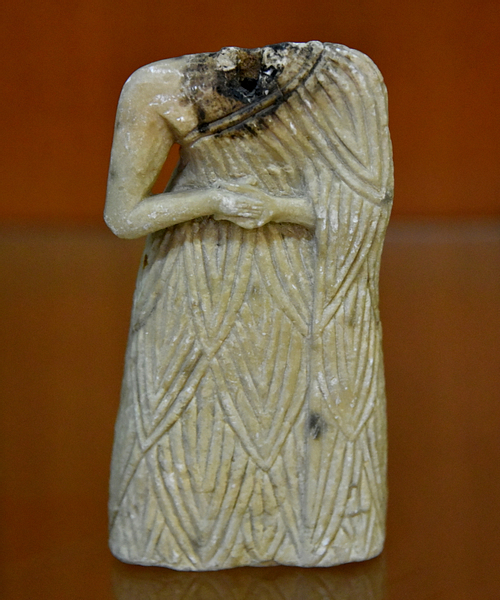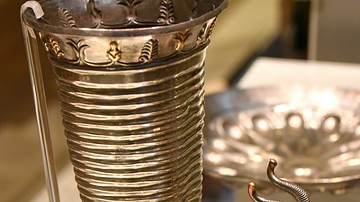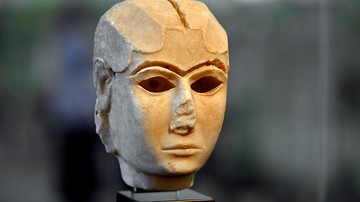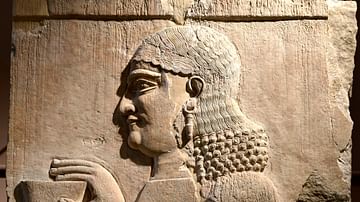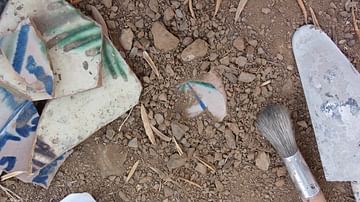For how long do we build a household?
For how long do we seal a document?
For how long do brothers share the inheritance?
For how long is there to be jealousy in the land(?)?The Epic of Gilgamesh, chapter 10, Tablet X.
I have always been fascinated by the Gilgamesh-related immortality perspective. Nobody can live forever. However, the human soul and its achievements are still able to navigate through the universe, beyond the time factor, and reach a distance seemingly beyond our imagination. The aftermath of the Frist World War (1914-1918 CE) gave birth to what we call today the Republic of Iraq as well as its borders. Thus, destiny made Iraq the legitimate heir of the Mesopotamian legacy. Before then, the "Land between the Two Rivers" went through several millennia of turmoil.
![Statue of a Female Sumerian Worshipper from Khafajah [Detail]](https://www.worldhistory.org/img/r/p/500x600/9695.jpg?v=1733478187)
Since the mid-19th century CE, Mesopotamia has been a target for eager and ambitious archaeologists. Decade after decade, the earth strata of the land of Iraq has been yielding ancient artifacts, one after another, which have not only been able to semi-satiate, or at least please, our curiosity about our ancestors, but they have also taught us endless lessons about humanity and its surrounding domains of living, religion, everyday life activities, wars, etc.
The black tragedy (or I better coin it as a black comedy) of the ransacking process of the Iraqi Museum in Baghdad, after the dramatic collapse of Saddam's regime in April 2003 CE, incited an international outcry about the looting and dispersion of the plundered artifacts. This Mesopotamian heritage, in my opinion, does not belong to Iraq (verbally saying); it is a humanity-owned bequest. All of us, regardless of our citizenship, race, or ethnicity have the commitment to preserve and deliver it to the future generations.
The Oriental Institute of the University of Chicago, USA, took the very first and outstanding initiative to tell the world about this massacre of the Iraqi Museum's collection. They set up a new webpage on their website on April 15, 2003 CE, just a few days after this pillage, sending a worldwide message to the people about the lost, stolen, or probably “status unknown” Mesopotamian artifacts. In addition, they created a mass “mailing list” about the lost items from the Iraqi Museum and designated it as the “IraqiCrisis”; don't hesitate to subscribe, as it is still active. However, the pertinent webpage about the robbed Mesopotamian artifacts was last updated on April 10, 2008 CE.
The Oriental Institute sent many archaeological and excavation teams to Iraq in the early 1930s CE, for instance to Khafajah (ancient Tutub) and Tell Asmar (ancient Eshnunna). Many seasons of lengthy and scientific digging and unearthing had yielded an innumerable collection of a multitude of priceless Mesopotamian artifacts in addition to ruined cities temple remains, etc. For example, Khafajah (also Khafaje) underwent seven seasons of excavation while six seasons were spent at Tell Asmar. Both of these Sumerian (and later Akkadian) cities lie within the so-called Dyala Valley, north-west of Sumer proper and east of the modern city of Baghdad, the capital of Iraq. The University of Pennsylvania and the American Schools of Oriental Research joined the work during some seasons.
The Oriental Institute has published many elaborate preliminary and final reports in addition to reports about the progress of their work. After almost 88 years, and not surprisingly, many scholars still study and publish their findings and conclusions about those Oriental Institute-found Mesopotamian artifacts.
How did the story begin?
The Sulaymaniyah Museum has been undergoing extensive renovation work since early October 2018 CE, thanks to the USA embassy in Iraq (the sponsor of that project). A very large hall will be dedicated to the pre-historic items from Mesopotamia, including Iraqi Kurdistan. The old display cases were being emptied from their contents and packed for storage; luckily, one day I was there! I was able to examine many artifacts closely, without a barrier, hold them, and shoot 100s of photos! In doing this, many unseen details of the displayed articles have become crystal clear; you can see the back, side, and under-surface of the item. Words and numbers (written with ink and pen) you can spot on the surface. A number on one of the artifacts (composed of a couple of small letters combined with Roman and Arabic numerical) drew my attention. It was “Kh. IV 288”; the “IV” was not that oblivious and appeared as “TV” because the lower part was partially covered with an old type of glue (see the details about the first statue below). Just a couple of days later, and what a coincidence, French archaeologist Sophie Cluzan contacted me about my images of the Early Dynastic Sumerian statues at the Sulaymaniyah Museum; the statue with the “Kh. IV 288” was one of them. Sophie asked me where they were found? The statues' description says that they are from Mesopotamia; full stop. Their “precise provenance of excavation” was not mentioned. This prompted me to ask my dear friend Hashim Hama Abdullah (the director of the Sulaymaniyah Museum) about these statues' provenance of excavation. Hashim said we have to see their archives.
Thanks to Hashim, I was able to access the statues' archives. We searched extensively but the information was scarce. Hashim suggested that the letters “Kh.” refer to the site of excavation and the “IV” or “TV” may be their stratum. Excellent, that was just the end of the thread. What does “Kh.” reflect? I made a thorough Google search and found that this is “Khafajah” and the Oriental Institute was the body which had conducted the work in the 1930s CE (IV refers to their 4th season). I read their reports, which are available on their website as free PDFs, and found that many artifacts currently housed at the Sulaymaniyah Museum were excavated by them; for instance, a group of 8 nude female statues from Nippur (which are on display within a single case).
The next step was checking out the Oriental Institute's “Lost Treasures from Iraq” webpage. I found many artifacts, which were labeled as “status unknown”. The images (in black and white) on their website were taken from the book “Sculpture of the Third Millennium B.C. from Tell Asmar and Khafajah” by Henri Frankfort, which was published in 1939 CE.
The Sulaymaniyah Museum was opened on July 14, 1961 CE. On October 2 to 4, 1961 CE, the Sulaymaniyah Museum got 602 artifacts from the Iraqi Museum in Baghdad as a permanent loan. As the years went on, other items were gradually added to the collection. Currently, the Sulaymaniyah Museum is the second largest archaeological museum in Iraq (after the Iraqi Museum in Baghdad) and the largest one in Iraqi Kurdistan, in terms of its content and building capacity. I have chosen four items to address:
- All of these artifacts were part of that permanent loan of October 1961 CE.
- All of them carry an Iraqi Museum number acquisition/storage number in addition to other numbers (I will mention them in detail below).
- All of them are on display at the Sulaymaniyah Museum; two of them are at the Hall of Masterpieces and the two others are within the display case of Early Dynastic Period (2900-2350 BCE).
- Their registers mention a very brief general description of the artifact in Arabic (less than one line), its material, and era (in general). No single measurement was given.
The images below were shot by me on December 3, 2018 CE, between 10:00 to 11:00 AM while the artifacts were being packed for storage. A Nikon 710 camera with an AF-S NIKKOR 28-300mm f/3.5-5.6G ED VR lens was used. I had no time to arrange for a good ambient light and environment; I had to shoot immediately on the spot!
1. Head and Statue of a Sumerian Worshiper
![Statue of a Female Sumerian Worshipper from Khafajah [Front View]](https://www.worldhistory.org/img/r/p/500x600/9674.jpg?v=1618578907)
This is my favorite one, and always has been, and it was the one which has revealed the truth! It is on display within a modern display glass case, together with the Sumerian statue below. The Oriental Institute has labeled it as having “status unknown” and only the head of the statue appears on its website and all of the Oriental Institute's publications; an image of the statue's body could not be found in any publication.
a. It was excavated by the Oriental Institute at the Sin Temple, the city of Khafajah during the 4th season, 1933/1934 CE. It carries the excavation number of “Kh. IV 288”, which can be found at the back of the neck. The head has no Iraqi Museum (IM) number. It dates back to the Early Dynastic III period, c. 2400 BCE.
![Statue of a Female Sumerian Worshipper from Khafajah [Rear View]](https://www.worldhistory.org/img/r/p/500x600/9677.jpg?v=1599123603)
b. At the upper part of the back of the statue, the following numbers can be found: SM184 (Sulaymaniyah Museum, before 1991 CE, the year of the Kurdish uprising), SM945 (Sulaymaniyah Museum, after 1991 CE), and IM19651. The Iraqi Museum number was written, using a black ink, on the glue joining the two broken parts of the statue's torso (waist). The excavation number lies partially beneath the glue joining the neck and the upper chest. Therefore, it seems that the three fragments were joined altogether and then the whole piece was given an IM number by the Iraqi Museum.
c. The statue is footless and there is a dowel hole at the lower surface.
d. The statue represents a female wearing a Sumerian dress, with a bare right shoulder. Her hairstyle was finely carved. The hands are clasped in a gesture of prayer. She looks forward; the eye sockets were filled in with a white shell set on bitumen. The right elbow and forearm were restored while the left upper limb's fragments were joined. The hands are disproportionally large when compared to the head.
e. I could not find from where the torso had come. No single document or record mentioned it; the Oriental Institute's publications have no image of it and it carries no Khafajah's excavation number. The head's limestone is somewhat different from that of the body. The body might be found separately at some point, donated by someone, purchased by the Iraqi Museum, or seized by the pertinent authorities later on. The assemblage of the fragments was very likely done by the Iraqi Museum and not the Oriental Institute's excavation team; but when? Somewhere between the early 1940s and 1961 CE? The Sulaymaniyah Museum received the whole statue in 1961 CE. The statue, superficially, looks like a complete one. However, it is very likely that the body does not belong to the head excavated by the Oriental Institute.
![Statue of a Female Sumerian Worshipper from Khafajah [Right Side]](https://www.worldhistory.org/img/r/p/500x600/9675.jpg?v=1599123603)
f. The type of the glue used to join the fragments was a very well-known one in Iraq. The glue is very apparent and has imparted an unacceptable dark brown hue at the adjoining margins.
g. The head's height is 4.8 cm while the entire statue's length is 20 cm.
h. Now we know that the head is housed at the Sulaymaniyah Museum. Case solved; the “unknown status” should now be changed.
2. Headless Statue of a Sumerian Worshipper
![Statue of a Sumerian Male from Khafajah [Front View]](https://www.worldhistory.org/img/r/p/500x600/9678.jpg?v=1599123603)
This statue is on display within the same glass case of the aforementioned statue (and just behind it), at the Hall of Masterpieces.
a. It was excavated by the Oriental Institue at the Small Shrine, the city of Khafajah during the 3rd season, 1932/1933 CE. It was marked (at the lower surface of the flounced dress) with the excavation number of “Kh. III 1008”. The Sulaymaniyah Museum states that it has the numbers of IM46274, SM611, and SM1332. However, the Iraqi Museum number cannot be found on the statue itself.
![Statue of a Sumerian Male from Khafajah [Rear View]](https://www.worldhistory.org/img/r/p/500x600/9681.jpg?v=1599123603)
b. It is about 31 cm in height, made of limestone, and dates back to the Early Dynastic Period, 2900-2350 BCE.
c. It represents a standing male figure. The head and head/neck, right upper limbs, and both feet are missing. He wears the typical Sumerian flounced garment.
d. The lower part of the torso is hollow and was filled in with a modern play-doh, which also forms the flat lower end of the statue; the body sits on this.
![Statue of a Sumerian Male from Khafajah [Right Side]](https://www.worldhistory.org/img/r/p/500x600/9679.jpg?v=1599123603)
e. The Oriental Institute webpage of Lost Treasures from Iraq does not mention a specific status (e.g., known, unknown, or stolen). Anyway, it has been housed at the Sulaymaniyah Museum since October 1961 CE. Case solved!
3. Headless Statue of a Sumerian Worshipper
![Statue of a Sumerian Female from Khafajah [Front View]](https://www.worldhistory.org/img/r/p/500x600/9682.jpg?v=1599123603)
The statue (together with two other statues from Khafajah), is on display within a separate old wooden/glass container at another hall.
a. It was excavated by the Oriental Institute at the Sin Temple, the city of Khafajah during the 4th season, 1933/1934 CE. The body (not the feet) has the excavation number of “Kh. IV 115” and IM19603. The front of the base of the statue, below the feet, was marked with SM183 and SM944. The undersurface of the semi-rectangular base carries the number of “Kh. IV 49”; however, this was scratched out and “115” appears below it, marked using a different pen. The base itself was marked with the number of IM19664.
![Statue of a Sumerian Female from Khafajah [Rear View]](https://www.worldhistory.org/img/r/p/500x600/9685.jpg?v=1599123604)
b. The original statue, when found, was headless and composed of two fragments joined together at the middle part of the torso. From the lower surface of the torso, two very short cylindrical projections can be seen, representing the legs. The base/feet do not appear in the photos of the Oriental Institute's publications. The statue represents a standing female figure with clasped hands, in the typical Sumerian prayer gesture. It dates back to the Early Dynastic II, c. 2600 BCE. Its height (with the base) is 24 cm. It is, relatively, a heavy one, made of limestone.
c. The feet (from just below the ankles) rest on a semi-rectangular base; this forms the 3rd fragment. This fragment has a different color and an “IM” number from the statue. However, a close examination of the back of the base shows that it somewhat complements the lower edge of the flounced dress but its width is less than that of the lower end of the garment!
![Statue of a Sumerian Female from Khafajah [Right Side]](https://www.worldhistory.org/img/r/p/500x600/9683.jpg?v=1599123604)
d. The Oriental Institute's photos show that this headless statue (in two joined fragments) does not have a base/foot piece. The base fragment may belong to the statue and might well have been found later on or donated by someone, purchased, or seized. Or very likely, it is a gypsum copy which was made to complete the statue. When did this fragment join the statue? It is unknown, but probably at some point between the early 1940s to 1961 CE by the Iraqi Museum.
e. The Oriental Institute website of Lost Treasures from Iraq says that it has an “unknown status”. We know now that it has been housed at the Sulaymaniyah Museum since October 1961 CE. Case solved!
4. Head of a Sumerian Male
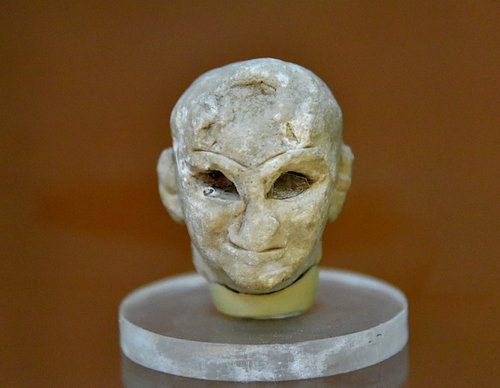
This small head, made of limestone, is about 3.7 cm in height. It is on display inside an old wooden/glass case of artifacts from the Early Dynastic Period. It was placed in front of a group of nude female statuettes from Nippur (the group was also excavated by the Oriental Institute). You can very easily overlook it! Nothing is special about it, evidently, and there is no description beside it. What drew my attention is that it reminds me of an African American boxer after finishing a heavy fight; his face is swollen and his nose is deformed!
![Head of a Sumerian Male from Tell Asmar [Right Side]](https://www.worldhistory.org/img/r/p/500x600/9687.jpg?v=1599123604)
a. The Oriental Institute excavated this head (without a body) at the Single-Shrine, Temple of Abu of the city of Tell Asmar in 1933 CE.
![Head of a Sumerian Male from Tell Asmar [Rear View]](https://www.worldhistory.org/img/r/p/500x600/9689.jpg?v=1599124502)
b. The back of the head was marked with the numbers of “As. 33:500”, IM19772, SM181, and SM627. In the image above, you can see that I hold the head of the statue with my left hand.
c. The head sits on a modern circular plastic base.
d. The Oriental Institute website of Lost Treasures from Iraq says that it has an “unknown status”. We know now that it has been housed at the Sulaymaniyah Museum since October 1961 CE. Case solved!
There are two more headless statues from Khafajah which I have not addressed here. They are not on the list mentioned by the Lost Treasures from Iraq webpage. One was a donation to the Iraqi Museum (date not mentioned, probably by a worker who excavated the site with the Oriental Institute) and the other is of a female with an elaborate flounced dress.
Headless statue of (probably a female) figure from Khafajah at the Sulaymaniyah Museum, Iraqi Kurdistan. This was donated to the Iraqi Museum in Baghdad; the name of the donating person and the date of donation were not mentioned in the registers. This statue is not on the Oriental Institute's list of Lost Treasures from Iraq.
Headless statue of a female figure from Khafajah at the Sulaymaniyah Museum, Iraqi Kurdistan. This statue is not on the Oriental Institute's list of Lost Treasures from Iraq.
What my article reflects is the deep and profound miscommunication or disconnection between the pertinent bodies responsible for the storage and display of these artifacts. When the artifacts were acquired by the Sulaymaniyah Museum in 1961 CE (as a permanent loan from the Iraqi Museum), they were accompanied by two registers (the 2nd one was a copy of the first register but it was written by another employee and using a different ink pen). Both registers were given the number 7 and were opened on October 2, 1961 CE. The artifacts were registered serially, starting from 1 and ending with 602, over a period of 3 days, from October 2-4, 1961 CE. The details of the 602 artifacts within both registers were very superficial and brief, many times incongruent, and occasionally misleading; e.g., register two says that the above Sumerian statues are from Tepe Gawra (an ancient mound near Mosul, Nineveh Governorate, northern Iraq) and the small male head is from Kish! The registers give no dimensions at all.
I had to dig deeply for this information, both at the Sulaymaniyah Museum and through the Oriental Institute's publications. I'm very happy to see that some of the “Lost Treasures from Iraq” are actually housed at the Sulaymaniyah Museum and that they were not stolen! On the other hand, it is very painful to see that the great work of the Oriental Institute achieved at Khafajah and Tell Asmar has been shattered among bureaucracy, lack of proper documentation, and miscommunication, and above all, ignorance.
I cannot express enough my sincere gratitude to Hashim Hama Abdullah, the director of the Sulaymaniyah Museum. Without his kind and unlimited cooperation and help, this article would not have been published. I am (as an Iraqi citizen) very grateful to the Oriental Institute of the University of Chicago for all the Mesopotamia-related work they have done so far. In addition, their perspective of putting their 88-years-old archives of excavation reports related to Mesopotamia, as free PDFs, is very much appreciated; a gesture that is rare nowadays.
I'm not a historian but I can get interested - obsessively interested - with any aspect of the past, whether it's palaeontology or archaeology or the very recent past. Penelope Lively

